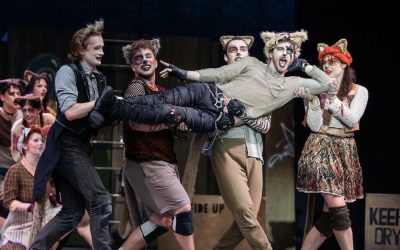
Shayna Jones. Set and costume by Cecelia Vadala. Lighting by Brad Trenaman
(Photo: Sarah Race)
I’m white and urban writing about playwright Shayna Jones’s exploration of being Black and rural. Keep that in mind as you read this.
In her solo show Black & Rural, which she has written and is now performing, Jones tells us that she lives in a mountain village of 800 people — and she’s one of the only Black people within hundreds of miles. As such, she feels constantly observed by her well-meaning, mostly white neighbours and constantly called upon to perform. After George Floyd was murdered by Minneapolis police officer Derek Chauvin, Jones’s village held a Black Lives Matter march and, just by showing up, Jones became the day’s unwilling star. She appreciated the community’s action, but resented being thanked for the “enrichment” that her presence brings to the community. Within the message that her presence is exceptional, Jones heard the warning that she doesn’t belong there.
She tells us that, reeling from the alienation of this BLM experience, she set out to interview other Black and rural Canadians — searching, presumably, for some sense of solidarity and validation, some understanding of herself within a like-minded community. Over 18 months, she had 40 conversations that went on for “hours and hours.” From this research — and rumination — Black & Rural has emerged.
To present the results, Jones has written a 70-minute show that largely consists of newly invented “folktales”.
Although I’m sympathetic to Jones’s easily-imaginable sense of otherness, Black & Rural bored the pants off me.
The script is relentlessly abstract.
I was riveted by the first “folktale”. Really an associative yarn spun only by Jones, not by any other folk, it’s about an abandoned baby brought to ecstatic life by a wise woman who opens its senses. Cool.
But the yarns piled up and, for me, they quickly lost their resonance. The tone of the writing is always the same and, under Richard Wolfe’s direction, so is Jones’s exaggerated delivery. She puts so much emphasis on every word it’s like she’s an old-fashioned Shakespearean actor or a constantly startled performer in bad kids’ theatre.
The stories bear little relationship to the interviews she conducted and they don’t add up to much of an arc.
Considering that Jones had conversations with 40 individuals, she allows voices other than her own precious little airtime. I remember hearing from three other people. And I’ve got to say I barely heard them; the brief snippets of interviews are so badly recorded, they are largely unintelligible.*
And there’s a weird disjuncture between those interviews and Jones’s response to them. One of her subjects, a guy who seems quite happily rural, talks about how much he enjoys being in the forest. But the story that Jones spins out of this is about Black vulnerability to violence. That vulnerability is mortally real, of course, but my dominant impression was of Jones’s insistence on a narrative of exclusion.
And, as I said, her character’s journey in this piece doesn’t have much shape. In her interviews, she finally talks to a guy who expresses a connection to the land in terms that resonate with her — and there’s supposed to be some kind of resolution in that. But she’s already told us that she is connected to the land. Now she has a bit of company in that experience, which is great, but there’s no mention of the other side of the equation, the character’s discomfort with her white neighbours.
And, again, that speaks to the problem of the script’s abstraction. Throughout, Jones is defined predominantly by her Blackness, her neighbours exclusively by their generic whiteness. Because Jones doesn’t introduce us to any friends or other significant individuals in her village, there’s no room for nuance or development in her relationships with her neighbours. Black & Rural stays stuck firmly in Jones’s head.
Rufus Cappadocia’s score is propulsive. Cecelia Vadala’s elemental set design — a group of thick ropes hanging from the ceiling — is gorgeous. And Brad Trenaman’s lighting, which leans heavily into chiaroscuro, is evocative.
Still, 20 minutes into this 70-minute piece, I was checking my watch.
BLACK & RURAL by Shayna Jones. Directed by Richard Wolfe. A Pi Theatre production presented by Pacific Theatre. At Pacific Theatre on Saturday, March 31. Running until April 15. Tickets
* The publicist for Black & Rural has written to let me know that, because several audience members complained about the sound quality of the recorded interviews, the company has re-recorded them with professional actors.
NEVER MISS A REVIEW: Sign up for FRESH SHEET, my weekly e-letter about the arts.





Yes, you are white and urban. I am Black, rural and one of the voices in Shayna’s piece. I’m also a published short story writer, whose 1st vol. of a 4 vol. novel “Backstory: The Many Lives of Granville Johnson” will be on the bookstore shelves in early Nov. (published by FriesenPress). I live in a remote rural community of 30 pop. I am the only Black person for 100 mile radius. I am known through out the area for what I am and what I do, both in a positive experience with much admiration and support, also with serious bigotry expressed in violent aggression. Everyone in my community and in 5 other communities along the East Line outside of Prince George BC are White.
The point being that to live in a ‘fish bowl under a magnifying glass’ of isolation as the only representative of your race and culture in a sea of White lives, friends and foe alike, is difficult to fathom unless you live it.
I have lived in Vancouver for ten plus yrs. and was a successful independent artist (dancer), writer and musician, djembe player with Jack Velker, Sunday Night Soul Service. I understand that the urban lifestyle can be numbing and sensory overstimulating. The need for constant change and variety in order to retain audience attention and retention was one of my complaints as a performer navigating the fickle ever changing urban audience appetite.
The remote rural life style is subtle by nature. The Black reality in that deep green quiet, seasonal rather than periodic, yet rich in meaningful human interactions, is the stuff of dreams within dreams with nightmares. Suspension of the urban bias to truly transform consciousness within the Shayna’s 70 min. kaleidoscopic sharing of a very special universal experience that is our lives in the hinterland was perhaps in your case simply a ‘bridge too far’. Your watch evidently was far more entertaining.
Granville Johnson
Well, this is a disappointing, narrow review. It seems you have taken a work of art personally, which is always a mistake. To the point of Ms Jones’ opening lines “ folktales don’t give two shits about the rationale western mind” (or something close to that), this review is evidence of your (self declared) bias.
I sat behind you the entire performance while you scribbled furiously in the dark throughout the piece. Rather than listen ( which was the opening imperative), absorb and learn from the offering you chose to retreat into a pre conception of narrative. There were gorgeous moments of magical realism that you didn’t even see – or hear for that matter.
I also feel the review was lazy, and solely focused on tearing down Ms Jones. Your description of the production was nearly dismissive of the level of artistry in all aspects. To say the music was propulsive is a poor and perhaps ambiguous choice – the score was magical, and was itself a character! How did you miss this? Happy to read your positive review on the exquisite set and lighting though.
I feel like this review is unthoughtful, unhelpful, narrow and unnecessarily harsh. Maybe you weren’t paying attention, but you also included some false information — there were far more than 3 voices included in this performance art piece. And the recordings sounded clear and professional. Weird and confusing for you to include this…? But why should you even care how many voices were in HER piece? Is her person experience not valuable enough for you? If she was stuck in her own head, i can tell you, that is a head I WANT to be stuck in. Exposed, honest, pained, connected, REAL. Maybe you were bored because you weren’t listening? Maybe you weren’t listening because you actually don’t care about her experience. Maybe you couldn’t remove your lens of the white gaze? Couldn’t look away but couldn’t give a shit at the same time. She actually talked about people doing that to her, and you kinda just proved her point. And maybe you couldn’t possibly accept a theatrical style different than your own pretentious expectations (folk tales, spoken word, and personal experience narratives.) And to post this just after opening night .. ? Trying to sabotage a rural-living black woman’s extremely personal and exposing work… nice. I guess Vancouver just loves to be a cruel place, especially to BIPOC people.